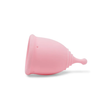
Do you frequently change your tampons or pads? Do your periods last much longer than they used to? Or do you have both of these issues?
A number of reproductive disorders, including uterine fibroids, can cause irregular bleeding.
What Exactly Are Uterine Fibroids?
Heavy menstrual bleeding, or menorrhagia, affects up to 35% of women in their reproductive years. This could be an indication of uterine fibroids or myomas, which are noncancerous growths that form in or around the uterus.
Fibroids can develop at any point during the reproductive years - from the beginning of menses until menopause, owing to the female hormones oestrogen and progesterone. These hormones drive fibroid growth and don't usually go away on their own. However, they do shrink after menopause.
Uterine Fibroids Are More Common Than You Think
By the age of 50, 20 to 80 % of women (in the United States) are projected to have fibroids.
The large variety in prevalence is due to the fact that many women are unaware they have fibroids, which are most frequent in women in their 40s and early 50s. Fibroids can emerge out of nowhere and then vanish after menopause, and you may be completely unaware of it.
Symptoms to Be Aware Of
Uterine Fibroids, in most cases, do not produce symptoms at all, or only cause minor symptoms. In some cases however, you can observe severe symptoms such as:
• Lower back discomfort
• Frequent urination
• Painful intercourse
• Pressure in the abdomen
• Long periods of painful cramping
• Bleeding in between periods
• Difficulty bending over
Uterine Fibroids can create further difficulties, such as anaemia caused by heavy bleeding. Fibroids may also induce the formation of new blood vessels, which can result in severe bleeding and spotting between periods. Fibroids in your uterus may keep it from contracting after your period, causing your bleeding to be prolonged.
How Uterine Fibroids Affect Pregnancy
Fibroids in the uterus can prevent an embryo from attaching to the uterine lining, leading to infertility, miscarriage, or premature labour.
The growing foetus is rarely impacted when a woman with one or more uterine fibroids becomes pregnant; however, the fibroids might make the pregnancy more uncomfortable. Hormone levels rise during pregnancy, which might fasten fibroid growth.
If a fibroid mass starts to die, the expectant mother may need pain medication until the mass decreases.
Tests to substantiate the cause
If your doctor suspects you have uterine fibroids, he or she may request an ultrasound or other more sophisticated testing, such as:
- An MRI can reveal the location and size of fibroids. It can also be used to rule out the possibility of cancer.
- Hysteroscopy — this procedure entails passing a long, thin tube into the vaginal canal and into the uterus to inspect the uterus's walls.
- Hysterosonography — Injecting saline into the uterus causes it to enlarge, making it easier to view with ultrasound.
Finding The Right Treatment
If you are experiencing heavy periods due to uterine fibroids, you should get them treated as soon as possible. Heavy monthly flow caused by uterine fibroids can be treated with:
-
Birth control pills
-
Hormonal IUDs
-
Hormone injections
-
Oral medicines, both hormonal and nonhormonal
-
Surgical excision of the fibroids
-
Hysterectomy
A new technique known as The Sonata® Treatment can also administer radio-wave energy directly to fibroid. Light anaesthesia or sedation, similar to that used during a colonoscopy, can be used to perform this treatment in an outpatient setting. With very low complication rates, this new approach also decreasing bleeding.
Can You Use A Menstrual Cup If You Have Uterine Fibroids?
Because menstrual cups are worn on the inside, they may cause problems for certain women who have fibroids. The cup's lengthy wear time — about 8 hours for the Femino Cup — and ease of use, on the other hand, may make it the best option for coping with those extra-long periods.
Even if you don't think you have fibroids, using a cup to track your flow can help you find out. If the amount of blood flow rises dramatically, or the blood looks to have more clots than before, you may have fibroids. This isn't necessarily a cause for concern, but it's something to bring up with your doctor.
Reducing The Risk
Exposure to some environmental elements, such as certain plastics, hair care products, cosmetics, and even repetitive handling of printed cash register receipts, is thought to alter hormone levels and increase risk.
Diet may also have a role. Tofu and other soy products, which include plant-based oestrogen, may increase risk; similarly, diets strong in red meat and poor in fruits and vegetables, as well as alcohol use, are questionable.
There are currently no known methods for preventing fibroids. However, eating a diet rich in whole grains, vegetables, fruit, and lean meats, as well as keeping a healthy weight and avoiding alcohol, can help protect against malignant tumours and a variety of other ailments.
Based on your age, desire for fertility, and the size and location of the fibroids, work with your doctor to identify the least invasive form of treatment.




Leave a comment